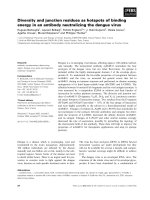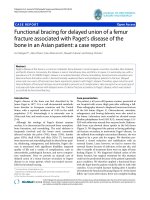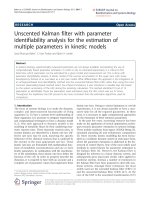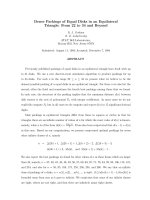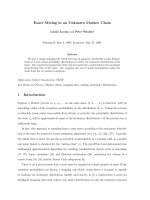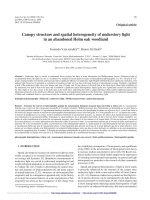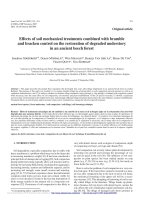Coordinated movement of multiple robots in an unknown and cluttered environment
Bạn đang xem bản rút gọn của tài liệu. Xem và tải ngay bản đầy đủ của tài liệu tại đây (3.08 MB, 129 trang )
COORDINATED MOVEMENT OF MULTIPLE ROBOTS IN
AN UNKNOWN AND CLUTTERED ENVIRONMENT
NG WEE KIAT
(B.Eng. (Hons.), NUS)
A THESIS SUBMITTED
FOR THE DEGREE OF MASTER OF ENGINEERING
DEPARTMENT OF MECHANICAL ENGINEERING
NATIONAL UNIVERSITY OF SINGAPORE
2004
ACKNOWLEDGEMENTS
This project will never be realized without the guidance of my project supervisor,
Associate Professor Gerard Leng. Since my undergraduate final project until my
Master research, he has been there to guide me. Throughout the entire span of
the project, he has helped me tremendously in finding my focus in the project, and
he has been always so willing to listen to my problems and ideas. He has
relentlessly met me for formal discussions at least once every week to make sure
I have been progressing in the right direction. I am truly amazed by his concern
for every one of his students despite his busy schedules and meetings he has to
attend. And also not to forget the birthday parties he initiated for the few of us
postgraduate students and the lunches and dinners that he treated us!
I will also like to thank my peers Mr Cheng Chee Kong and Mr Low Yee Leong.
We have been working together for more than a year and our relationship have
grew to more then just colleagues in a common laboratory but also friends who
are there to support. The nights that we spent searching and thinking for solutions
will be memories well treasured! In addition, they have provided me with a lot of
recommendations, insights and helped when formulating the search algorithm and
building the robots.
I would also like to express my heartfelt gratitude to Mr Cheng Kok Seng, Amy, Mr
Ahmad and Pricilla from the Acoustic and Dynamics Department; the
i
undergraduate students Han Yong, Vincent, Stephen, Kwang Cherg and Shing
Yen for providing me with all the technical and moral supports whenever I
needed; Master Graduate Mr Cheo for his advices.
In addition, my gratitude is also for DSO that has sponsored part of the project.
Nevertheless, my family and friends has played important roles in my study. Their
encouragements, concerns and support are more than meaningful and heartfelt.
And last but definitely not the least, I thank God, for his grace, and for all his great
blessings and love that he never fail to shower on me.
ii
TABLE OF CONTENTS
ACKNOWLEDGEMENTS.................................................................................... i
TABLE OF CONTENTS ..................................................................................... iii
SUMMARY ........................................................................................................ vii
List of Tables ......................................................................................................ix
List of Figures ......................................................................................................x
1 PROJECT DEFINITION ................................................................................ 1
1.1
Project Objective ..................................................................................... 1
1.2
Definitions ............................................................................................... 3
1.2.1
Search Environment......................................................................... 3
1.2.2
Target............................................................................................... 4
1.2.3
Search Technique ............................................................................ 4
1.2.4
Completion Of Search...................................................................... 5
1.3
Possible Real Life Applications ............................................................... 5
1.4
Thesis Outline ......................................................................................... 6
2 LITERATURE SURVEY ................................................................................ 9
2.1
Control And Architecture Of Multiple Robot System................................ 9
2.2
Target Search Using Multiple Robots.................................................... 13
2.3
Chapter Summary ................................................................................. 17
3 DESIGNING SYSTEM ARCHITECTURE FOR MULTIPLE ROBOTS ........ 18
3.1
Biological Inspirations For Coordinating Multiple Robots ...................... 19
3.2
Problem Characteristics Of Search ....................................................... 21
3.2.1
Unknown Environment ................................................................... 21
iii
3.2.2
Cluttered Obstacles........................................................................ 21
3.3
Search Tactic ........................................................................................ 21
3.4
System Architecture .............................................................................. 24
3.4.1
Criteria For Suitable System Architecture ...................................... 24
3.4.2
Decentralized Control..................................................................... 25
3.4.3
Autonomy....................................................................................... 27
3.4.4
Locality........................................................................................... 28
3.4.5
Homogeneity.................................................................................. 29
3.5
Chapter Summary ................................................................................. 31
4 DESIGNING INDIVIDUAL ROBOT REACTIVE BEHAVIOURS .................. 33
4.1
Considerations For Individual Robot Behaviours .................................. 33
4.1.1
Study Of System Architecture ........................................................ 33
4.1.2
Basic Requirement Of Mobile Robots ............................................ 35
4.2
Reactive Behaviours ............................................................................. 36
4.3
Formulating The Reactive behaviour .................................................... 38
4.3.1
Obstacles Negotiation .................................................................... 38
4.3.2
Migration ........................................................................................ 44
4.3.3
Homing........................................................................................... 46
4.3.4
Flocking.......................................................................................... 48
4.4
Chapter Summary ................................................................................. 59
5 HARDWARE IMPLEMENTATION .............................................................. 60
5.1
Construction Of Robot........................................................................... 60
1.1.1
Navigational Sensor ....................................................................... 60
2.1.2
Target-Detection Sensor And Robot-Detection Sensor.................. 62
3.1.3
Robot Mobility ................................................................................ 63
4.1.4
Processing Capability..................................................................... 65
5.1.5
Communication Ability.................................................................... 65
5.2
Features Of Robot................................................................................. 66
5.2.1
Photograph Of Robot ..................................................................... 66
5.2.2
Modular Structure .......................................................................... 67
iv
5.3
Chapter Summary ................................................................................. 67
6 TESTS ON ROBOT HARDWARE............................................................... 68
6.1
Test Of Individual Robot Reactive behaviours ...................................... 68
6.1.1
Obstacles Negotiation And Migration ............................................. 68
6.1.2
Homing........................................................................................... 71
6.1.3
Flocking.......................................................................................... 71
6.2
Target Search Experiment .................................................................... 75
6.2.2
Experiment Setup .......................................................................... 75
6.2.3
Procedure ...................................................................................... 77
6.2.4
Results And Evaluations ................................................................ 78
6.3
Chapter Summary ................................................................................. 79
7 PERFORMANCE ANALYSIS OF COORDINATED MOVEMENT............... 80
7.1
Simulation Program............................................................................... 80
7.2
Simulation Setup ................................................................................... 81
7.3
Experiments For Different Number Of Robots....................................... 83
7.3.1
Procedure ...................................................................................... 83
7.3.2
Results And Evaluations ................................................................ 83
7.4
Experiments For Different Size Search Area......................................... 86
7.4.1
Procedure ...................................................................................... 86
7.4.2
Results Evaluations........................................................................ 87
7.5
Chapter Summary ................................................................................. 89
8 CONCLUSION ............................................................................................ 90
8.1
Thesis Conclusion................................................................................. 90
8.2
Possible Future Works .......................................................................... 92
9 Bibliography ................................................................................................ 93
10 APPENDICES ............................................................................................. 98
CAD Drawing Of Robot.................................................................................... 99
Flocking Behaviour Experiment Data (Chapter 4).......................................... 100
v
3 Robots ..................................................................................................... 100
4 Robots ..................................................................................................... 101
5 Robots ..................................................................................................... 102
6 Robots ..................................................................................................... 103
Simulation For Validation Experiment (Chapter 6)......................................... 104
3 Robots ..................................................................................................... 104
4 Robots ..................................................................................................... 105
Performance Analysis (Chapter 7) ................................................................. 106
400m2, 3 Robots......................................................................................... 106
400m2, 4 Robots......................................................................................... 107
400m2, 5 Robots......................................................................................... 108
400m2, 6 Robots......................................................................................... 109
900m2, 3 Robots......................................................................................... 110
900m2, 4 Robots......................................................................................... 111
900m2, 5 Robots......................................................................................... 112
900m2, 6 Robots......................................................................................... 113
1600m2, 3 Robots....................................................................................... 114
1600m2, 4 Robots....................................................................................... 115
1600m2, 5 Robots....................................................................................... 116
1600m2, 6 Robots....................................................................................... 117
vi
SUMMARY
The objective of this project is to formulate an algorithm that will coordinate the
movement of multiple robots to search for a target inside an unknown and
cluttered environment. While doing so they are not provided with prior information
of the position of the target and are also not allowed to map the environment. In
addition, we will access the time taken for robots to complete their search for
different number of robots use and in different sizes of search areas.
The system architecture that we have designed for the multiple robots is
decentralized, autonomous, localized and homogeneous. Decentralization allows
each robot to do their own processing and decision-makings; autonomy allows the
whole robot system to function without human intervention once activated;
localization allows the robots to function using only information collected from
their local environment; and homogeneity requires all the robots to be built and
programmed in the same way. During the search the robots will traverse across
the search environment and turn back only when one of the robots reached the
periphery of the search environment or when they detected the target.
In order to realize the algorithm, we have formulated four different reactive
behaviours for all the robots. The first behaviour is obstacles negotiation, which
helps a robot find an obstacle-free path. The second behaviour is homing, which
will guide a robot towards the target upon detection. The third behaviour is
vii
flocking, which keeps all the robots close to each other when they are moving.
And the last behaviour is migration, which ensures the entire multiple robot
system to move in the intended search direction. A robot will only be adopting one
of these behaviours at any one time according to the behaviour’s importance.
Obstacle negotiation is the most important and indispensable behaviour followed
by homing, flocking and finally migration. With these four behaviours we
developed, the desired coordinated movement will be realized.
We have also studied our algorithm by implementing it on physical robots that we
built, and the observations were similar to that observed in simulations. These
robots have also been used to performed search experiments to validate the
feasibility of the simulation program.
Finally multiple simulations were performed to find out how the time taken
changed for different number of robots used and for different sizes of search
areas. The number of robots used was varied from three to six and the size of
search area from 400m2 to 1600m2.
viii
List of Tables
Table 4.1……………………………………………………………………………..….57
Table 6.1………………………………………………………………………………...78
Table 6.2………………………………………………………………………………...78
ix
List of Figures
Figure 1.1……………………………………………………………………………...….4
Figure 3.1………………………………………………………………………………..23
Figure 4.1………………………………………………………………………………..37
Figure 4.2………………………………………………………………………………..40
Figure 4.3………………………………………………………………………………..41
Figure 4.4………………………………………………………………………………..42
Figure 4.5………………………………………………………………………………..44
Figure 4.6………………………………………………………………………………..47
Figure 4.7………………………………………………………………………………..49
Figure 4.8………………………………………………………………………………..51
Figure 4.9………………………………………………………………………………..53
Figure 4.10………………………………………………………………………………54
Figure 4.11………………………………………………………………………………55
x
Figure 4.12………………………………………………………………………………56
Figure 4.13………………………………………………………………………………58
Figure 5.1………………………………………………………………………………..64
Figure 5.2………………………………………………………………………………..66
Figure 6.1………………………………………………………………………………..70
Figure 6.2………………………………………………………………………………..73
Figure 6.3………………………………………………………………………………..74
Figure 6.4………………………………………………………………………………..76
Figure 7.1………………………………………………………………………………..82
Figure 7.2………………………………………………………………………………..84
Figure 7.3………………………………………………………………………………..85
Figure 7.4………………………………………………………………………………..87
xi
Chapter 1
PROJECT DEFINITION
This project focuses on the problem of coordinating multiple robots to move in a
group inside an unknown and cluttered environment in search of a randomly
positioned target. In order to achieve this, we have developed an original
algorithm to coordinate our multiple robots, and then further tested its
effectiveness using our own simulation programs and robots that we built. In
addition we have gone on to quantify the performance of our algorithm by
analysing the time that the robots took to accomplish a particular target search
when the number of robots and size of the environment were changed.
1.1
PROJECT OBJECTIVE
The objective of this project is to formulate an algorithm that can coordinate the
movement of multiple robots to search for a target inside a cluttered environment.
No prior knowledge of the layout or position of target is given to the robots and
1
they will have to accomplish this without mapping the environment so as to
reduce the computational resources involved.
In view of this, there are three main challenges that we have to overcome.
The first challenge is to manoeuvre the robots in the absence of information about
the layout of the search environment. This implies that it is not possible to preplan the movements of the robots since information of the environment will only
be available as the robots explore it. Therefore, real-time decisions will have to be
made accordingly.
The second challenge is to coordinate the movement of multiple robots to move in
a given search direction in the presence of obstacles. Appropriate behaviours for
each robot must be designed so that they will not wander randomly in the search
area.
Last but not least, the third challenge is to gauge the overall performance of the
algorithm we have designed for coordinating the movement of multiple robots in
the search problem. The performance parameter is the time to locate a target and
experiments should be performed to analyse how it depends on the number of
robots and the size of the search area.
2
1.2
DEFINITIONS
1.2.1 Search Environment
The environment we are dealing with is strictly two-dimensional and cluttered
obstacles are expected. Therefore in order to facilitate possible extensions of our
project to future tests involving real life scenarios, we have developed our
algorithm with the use of the layout of a typical plantation as the search
environment.
According to our survey on existing plantations, the average diameter of a tree’s
trunk in a typical plantation (as shown in Figure 1-1) is about 0.4m and they are
grown approximately 8m apart in regular rows and columns. However, as these
dimensions are too big for us to replicate in our project tests, we have to scale it
down accordingly. We will scale the plantation according to the diameter of the
tree’s trunk relative to the diameter of the cylindrical obstacles (0.06m) we are
using. This will give us a scaling factor of approximately 6.7 (scaling factor =
0.4/0.06).
Therefore in our project, all the cluttered environments we are going to use for
experimentations will have obstacles of 0.06m in diameter and placed
approximately 1.0m – 1.2m apart in uniform rows. And hence the dimension of the
robots that can be used for the experiment should also not exceed 1m in length.
3
Figure 1-1
The figure shows a photograph of a typical plantation.
1.2.2 Target
The definition of our target is a beacon that can be identified and distinguished by
the robots. In addition, it is assumed that this target will be much slower than the
robots.
1.2.3 Search Technique
The method of search that the robots are required to adhere is described in the
following steps:
1. The multiple robots are to be released in any randomly chosen direction into
the cluttered environment.
2. The multiple robots have to traverse in a fix general direction across the
search environment.
4
3. In order to remain inside the search environment, the robots will have to make
a U-turn and move in another randomly chosen direction when they come to
the periphery of the search area.
4. All the multiple robots will then move together in this new direction.
5. Go back to Step 2 until the target is detected.
1.2.4 Completion Of Search
In this project the time to search is defined by the time it takes for any 3 robots to
locate the target. And a target is located when a robot moves within half a sensor
range from it.
1.3
POSSIBLE REAL LIFE APPLICATIONS
In this section we presents two real life scenarios that motivate this research.
Scenario 1: Six Hikers Lost In Mountains of South-western Washington
(Source: />
A group of three men and three women have gone for a day hike in the Siouxon
Peak area of the Gifford Pinchot National Forest, southeast of Mount St. Helens
but were reported missing the following morning after some of them failed to show
up for work. In the end they were hoisted to safety only on the third day by the
search helicopter. For such search mission, it would be extremely useful if upon
reception of the report, a group of well coordinated multiple robots were
immediately deployed to search the forested area so as to hasten the rescue.
5
Scenario 2: Terrorist Attack On World Trade Center In United States
(Source: )
After the collapse of the World Trade Center in Wall Street, U. S., damaged gas
lines, fires and cascading concrete has prevented rescuers from immediately
entering the area to look for the injured and dead. Therefore it would be extremely
useful if there were a multiple robot system that was able to search for those
survivors in such an unknown and hazardous environment. Even if some of the
robots were damaged or destroyed in the process, the rest should still be able to
continue if they were made robust enough. And once these robots have found
survivors in the ruins, they could send signals back to the base and then further
actions could be taken. This would enable the rescue mission to continue without
risking unnecessary human lives by sending human rescuers into the collapsed
buildings.
1.4
THESIS OUTLINE
The designing of coordinated movement of the multiple robots will be divided into
two parts. First we will be formulating the overall architecture of the multiple robot
system that will facilitate the search, and second we will come out with the
behaviours for the individual robots that will enable them to realize the search
technique required.
The contents of all the chapters are summarized below.
6
Chapter 2 will discuss the related works by other researchers. These works will be
presented in two parts – control and architecture of multiple robots, and target
search using multiple robots.
Chapter 3 will describe the architecture we have designed for our multiple robots.
We will be talking about how we have build a suitable system platform that will
enable the coordination of multiple robots to fulfil their tasks of searching the
cluttered environment. Our system architecture is one that is decentralized,
autonomous, homogeneous and localized.
Chapter 4 will describe the primitive reactive behaviours that we have developed
for the robots so that their collective activities can result in their coordinated
movement. These basic reactive behaviours are obstacles negotiation, homing,
flocking and migration. We will also be providing empirical simulation test in this
chapter to gauge the feasibility of these behaviours when implemented on the
robots.
Chapter 5 will discuss how we have implemented our algorithm onto a physical
platform. A robot that will be used for physical testing will be built.
Chapter 6 will present the tests of reactive behaviours using the robots that were
built. Experiments of the physical search will be performed and compared with
simulation results to validate the simulation program we developed.
Chapter 7 will show our analysis of the performance of our algorithm when
different number of robots and sizes of search area are used.
7
Chapter 8 will conclude and provide some recommendations for future work.
8
Chapter 2
LITERATURE SURVEY
The objective of our project is to formulate an algorithm to coordinate the
movement of multiple robots so that they can search for a target inside an
unknown and cluttered environment. In this chapter we will be giving a review of
some of the related works.
2.1
CONTROL AND ARCHITECTURE OF MULTIPLE ROBOT SYSTEM
Due to the potential applications and favourable state of technology, there is an
increasing interest in the research on the use of multiple robots. Just as in our
project, the means of controlling and organizing them have been the prime
motivation behind several of these researches.
One of the earlier works on multiple robots was Reynolds’ (1987) object oriented
simulation of a flock of birds that were able to move together, split at obstruction
and flock together again. He showed that by simulating the behaviours of collision
9
avoidance, velocity matching and flock centring for just the individual birds he was
able to create a flock when many of them were replicated.
Beni (1988) introduced a concept of distributed control with his CRS (Cellular
Robotic System). This system was made up of heterogeneous units working
individually according to their own internal clock, which would collectively produce
information for the system based on the patterns formed by their physical position.
These methods of implementing basic behaviour for multiple robot system soon
gained more significance as more researches were carried out. Kube and Zhang
(1992) used behaviour-based autonomous robots to solve a box-pushing task.
The robotic control operated according to five mechanism: (1) using a common
task and simple cooperation strategy of non-interference, (2) following other
robots, (3) using environment to invoke group behaviours, (4) using other robots
to invoke group behaviour and (5) using individual behaviour that was
independent of the group. Kube and Bonabbeau (2000) did a more refined study
on transportation by ants and replicated the behaviours onto a box-pushing task
performed by multiple robots. Arkin (1989, 1992) proposed Schema-Based
Navigation to control how robots could be moved to (forage) and retrieved
(acquire and deliver) their target by just programming them with the same
primitive behaviours, and by doing so they could already organize themselves to
collectively achieve their shared goal. He believed that by avoiding a global world
model, he could increase the real-time response of the robots. Arkin (1997) also
presented the study of approach to multi-agent robotics in the context of two
10
major real world system: (1) ARPA’s UGV (Advanced Research Projects Agency,
Unmanned Ground Vehicle) that was used for the design of formation behaviours
and real-time mission specification with commander intervention, and (2) three
Trash-collecting robots that won AAAI Clean-up-office competition in 1994.
Gage (1992) regarded this method of implementing basic behaviours on individual
robots as “simple, inexpensive, interchangeable, autonomous”, “rather then
through the explicit purposeful, complex, perception-based behaviour of a single
very expensive, highly sophisticated unit”. Similarly Parker (2002) programmed
her multiple robots with behaviours to solve a multiple moving targets observation
problem.
Payton et al (2001), Marrow and Ghanea-Hercock (2000), and Kube and
Bonabeau (2000), Israel et al (1999) being inspired by the self-organizing ability of
social insects, have controlled their multiple robots based on the fact that each
insect within the colony just has to perform simple and local tasks, and this would
result in a more complex global task being accomplished.
The works mentioned thus far have dealt with systems that were decentralized,
self-organizing and used local perception to invoke individual behaviour. This
means that the robots were required to explore the local environment as they
moved and according to the different sets of stimulants from the environment, the
robots would decide individually (decentralized control/decision-making) what kind
of behaviour it should display. Multiple robots that were coordinated in this
manner were also commonly termed as “Swarm” – Beni et al (1994) have
11
provided a more rigorous definition. Considering the scenario and requirements of
our project, these methods of controlling the multiple robots are indeed very
insightful especially when they had achieved their tasks in unknown environment
without using extensive computations.
However, there are also researchers that adopted another approach – a
centralized controller or planner to command the robots to perform specific
actions. Yamashita et al (2003) used a centralized control to predict and manage
the actions of each of the robots to do complicated forms of transportation tasks.
And during the execution of tasks, human interventions were present, but were
limited to solving deadlocking situations. Alami and Bothelho (2003) used a
planner to allocate tasks to different robots. The strategy was to decompose the
mission, decide on allocation of task, allocate the task, coordinate task
achievement and finally the actions were executed. Asama et al (1991) pointed
out that it was easy to implement, made good predictions and ensured collisions
avoidance using a central planner because it allowed proper management of all
the actions of the robots. However, although centralized approach could make
execution of task more accurate and controllable, a critical drawback was that it
required significant amount of knowledge from the entire environment before it
could work well. Modification might be possible to make this approach more
suitable for an unknown environment, but we would expect a concurrent increase
in computational resources involved.
12
Another aspect of discrepancies in the works can be found in the composition of
robots in the systems. When there was a common task, the multiple robot system
would usually be made up of homogeneous robots (Park and Mullins, 2003;
Payton et al, 2002; Payton et al, 2001; Kube and Zhang, 1992; Arkin, 1990;
Reynolds, 1987). For this, all the robots were the same and exhibit the same
reaction for the same set of stimulants. On the other hand, if more extensive task
allocation was required, a heterogeneous system was sometimes preferred
(Matari et al, 2003; Yamashita and Asama, 2003; Gerkey and Matari , 2002;
Beni, 1988). Comparing the methods used in these works with our project
requirements, we will probably only require homogeneous robots since all our
robots are used for a common search and do not have different tasks or tasks that
need further breaking down or reassignments.
2.2
TARGET SEARCH USING MULTIPLE ROBOTS
Depending on factors like the distribution of targets, type of environment, and the
quantity and ability of the searchers, different strategies have been used to
coordinate robots to carry out a desired search. Gage (1992) and SPAWAR
(Space and Naval Warfare Systems Center San Diego, 1998) coordinated the
robots into different formations according to three categories of search that they
identified: (1) Blanket coverage – to arrange static searchers in such a way that
they maximised the rate of target detection within the search area, (2) Barrier
coverage – to arrange static searchers in such a way that they minimized the
chances of the target slipping through the barrier, and (3) Sweep coverage – to
13

